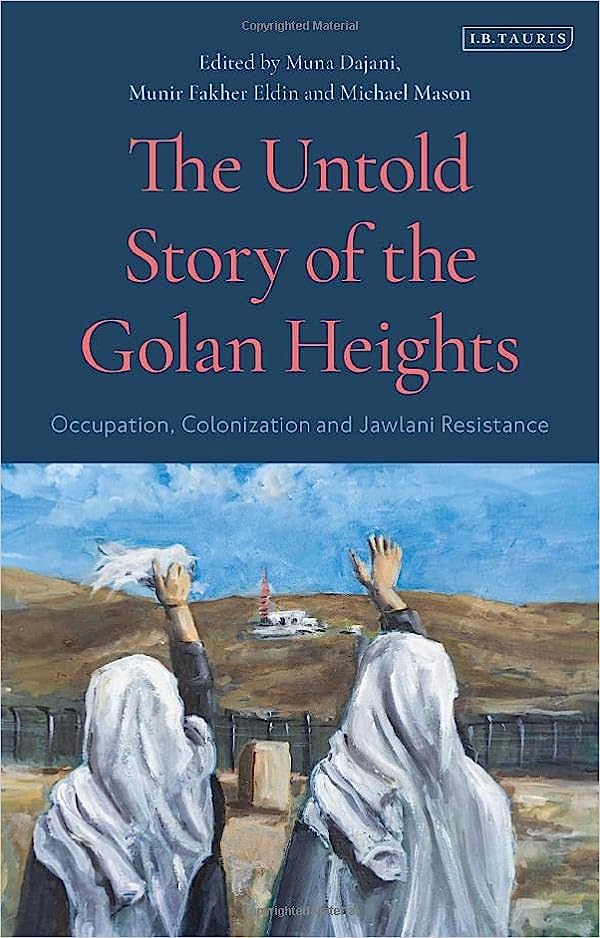The untold story of the Golan Heights
occupation, colonization and Jawlani resistance
- ISBN: 9780755644520
- Editorial: I.B. Tauris & Co. Ltd.
- Fecha de la edición: 2023
- Lugar de la edición: London. Reino Unido
- Encuadernación: Rústica
- Medidas: 22 cm
- Nº Pág.: 248
- Idiomas: Inglés

In 1967 Israel occupied the western section of Syria's Golan Heights, expelling 130,000 residents and leaving only a few thousand Arab inhabitants clustered in several villages. Sometimes characterised as the 'forgotten occupation', the western Golan Heights have been transformed by Israeli colonisation, including the appropriation of land and water resources, economic development and extensive military use. This landmark volume is the first academic study in English of Arab politics and culture in the occupied Golan Heights. It focuses on an indigenous community, known as the Jawlanis, and their experience of everyday colonisation and resistance to settler colonisation. Chapters cover how governance is carried out in the Golan, from Israel's use of the education system and collective memory, to its development of large-scale wind turbines which are now a symbol of Israeli encroachment. To illustrate the ways in which the current regime of Israeli rule has been contested, there are chapters on the six-month strike of 1982, youth mobilisation in the occupied Golan, Palestinian solidarity movements, and the creation of Jawlani art and writing as an act of resistance. Rich in ethnographic detail and with chapters from diverse disciplines, the book is unique in bringing together Jawlani, Palestinian and UK researchers. The innovative format - with shorter 'reflections' from young Arab researchers, activists and lawyers that respond to more traditional academic chapters - establishes a bold new 'de-colonial' approach.
1 Introduction: Representing the occupied Jawlan/Golan, Muna Dajani, Lancaster University, UK; Munir Fakher Eldin, Birzeit University, Palestine; and Michael Mason, LSE, UK
I: EVERYDAY COLONIZATION
Chapter 2: The Politics of Lifeworld Colonisation in the occupied Golan: Michael Mason, LSE, UK
Reflection 1: The 1982 General Strike, Bassel Rizqallah, Birzeit University student, Palestine
II: THE POLITICS OF THE GOVERNED
Chapter 3: Mapping the Politics of the Governed among the Jawlanis: A Semiotic Approach, Munir Fakher Eldin, Birzeit University, Palestine
Reflection 2: The occupied Syrian Golan and Birzeit University: A Story of Solidarity, Diaaeddin Horoub, journalist and researcher, Palestine
Reflection 3: The occupied Syrian Golan Heights after 2011: The Constant and Variable, Aram Abu Saleh, Syrian writer and activist, occupied Syrian Jawlan
III: THE POLITICS OF JAWLANI ART
Chapter 4: Sculptures in Jawlani Public Places: Reflections on the Work of Identity, Wael Tarabieh, Jawlani artist, and Munir Fakher Eldin, Birzeit University, Palestine
Reflection 4: The Jawlani Art and Cultural Scene, Abdel Qader Thweib, Birzeit University student, Palestine
Reflection 5: The Role of Literature and Folk Music in Resisting Israelization of the Jawlan, Nadine Musallam, journalist
IV: THE POLITICS OF JAWLANI YOUTH AND EDUCATION
Chapter 5: Israeli Education Policies as a Tool for the Ethnic Manipulation of the Arab Druze, Amal Aun, independent researcher
Reflection 6: How to Counter-map the Jawlani Lands: Visualizing Memory, Place and Identity, Jumanah Abbas, independent researcher
Reflection 7: The Concept of 'Jawlani Youth': Between Colonial Policies and Society, Ali Aweidat, Syrian researcher and activist, occupied Syrian Jawlan
V: A JAWLANI POLITICAL ECOLOGY
Chapter 6: Being in Place: On the Jawlan Formation and Agroecological History of Highlands, Omar Tesdell, Birzeit University, Palestine, Muna Dajani, Lancaster University, UK; and Alaa Iktash, Palestinian researcher, Al Quds (Jerusalem)
Reflection 8: From Jabal al-Shaykh to Mount Hermon Ski Resort, Alaa Iktash, Palestinian researcher, Al Quds (Jerusalem)
7 Conclusion: The Jawlan as Counter-Geography, Muna Dajani, Lancaster University, UK; Munir Fakher Eldin, Birzeit University, Palestine; and Michael Mason, LSE, UK







